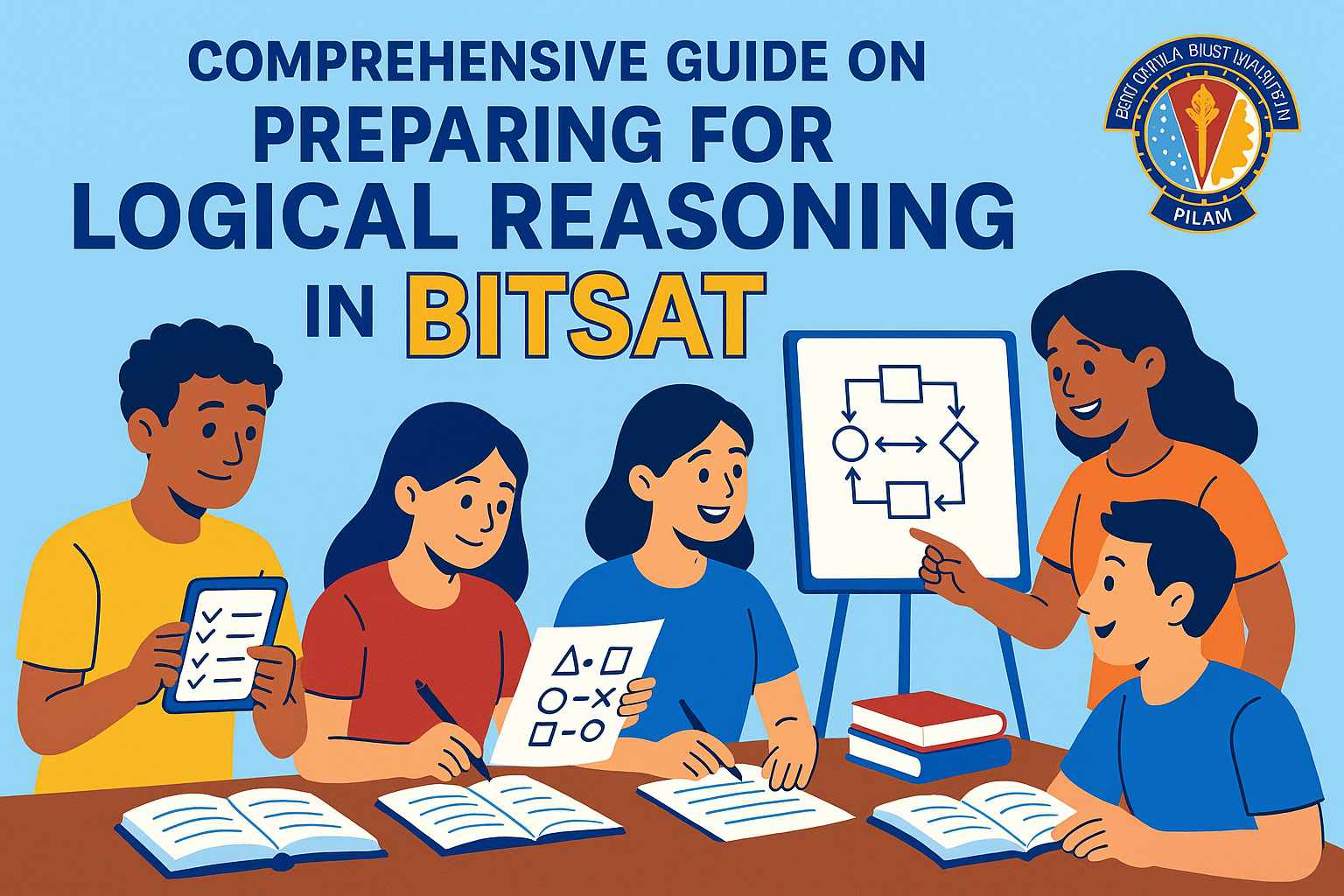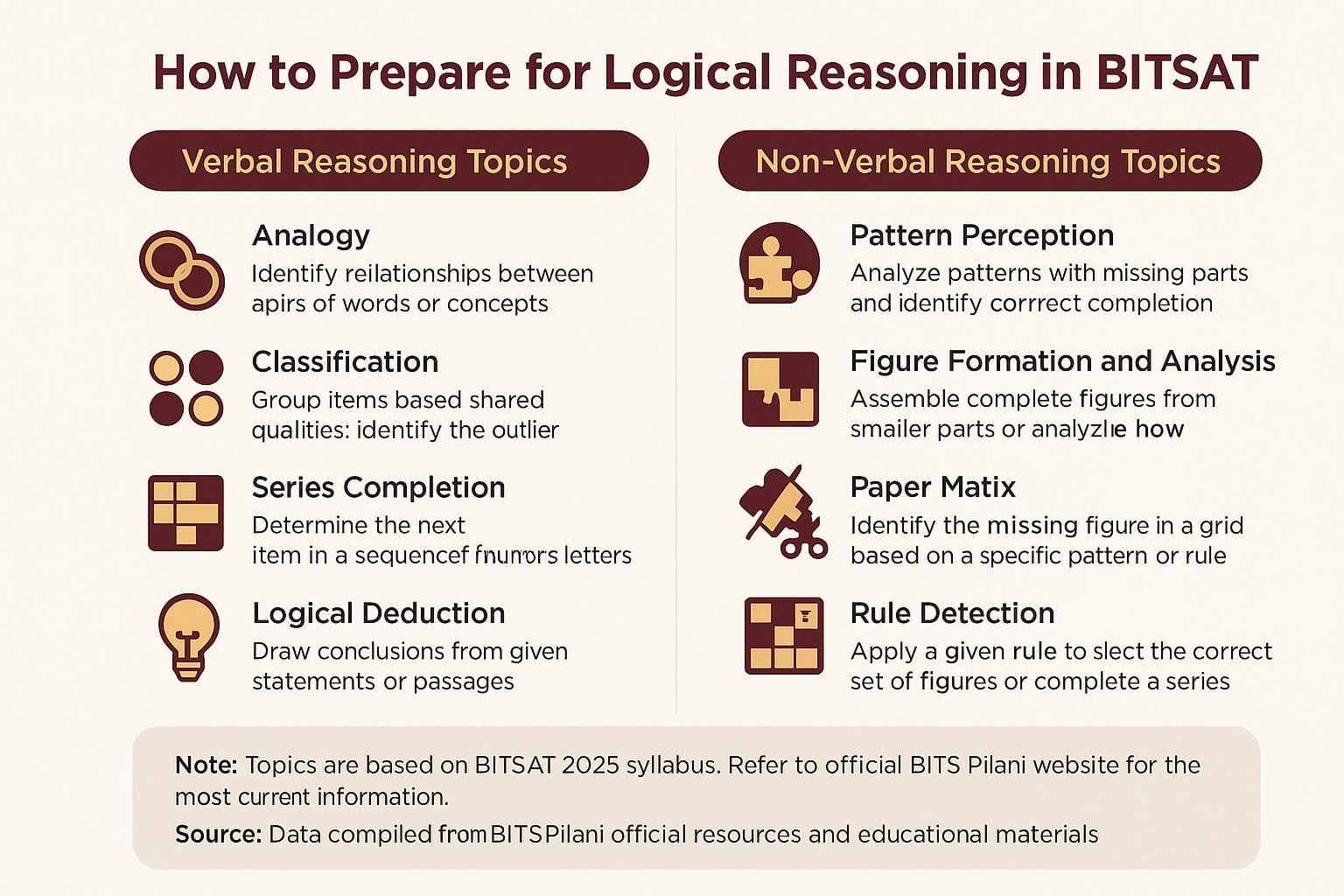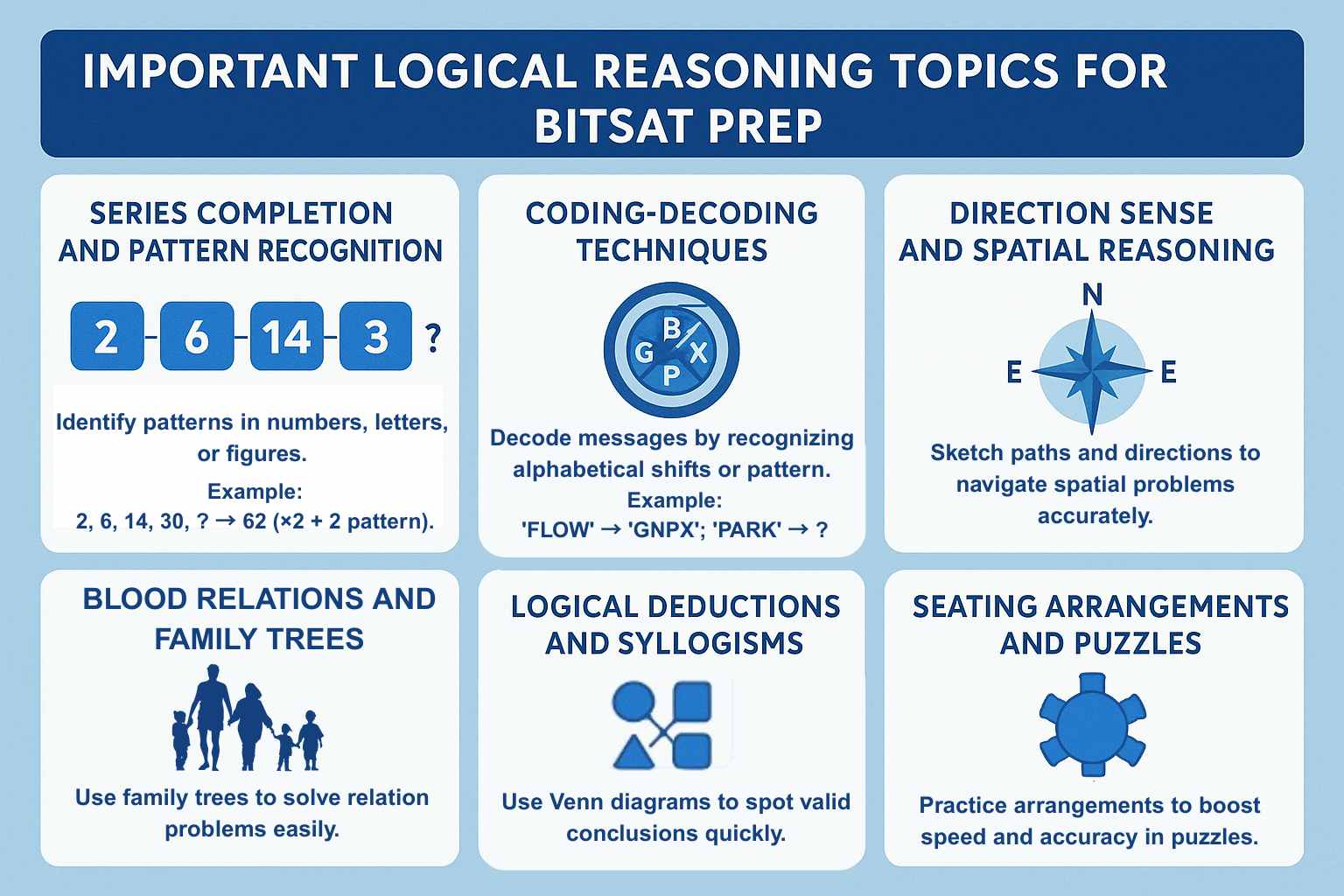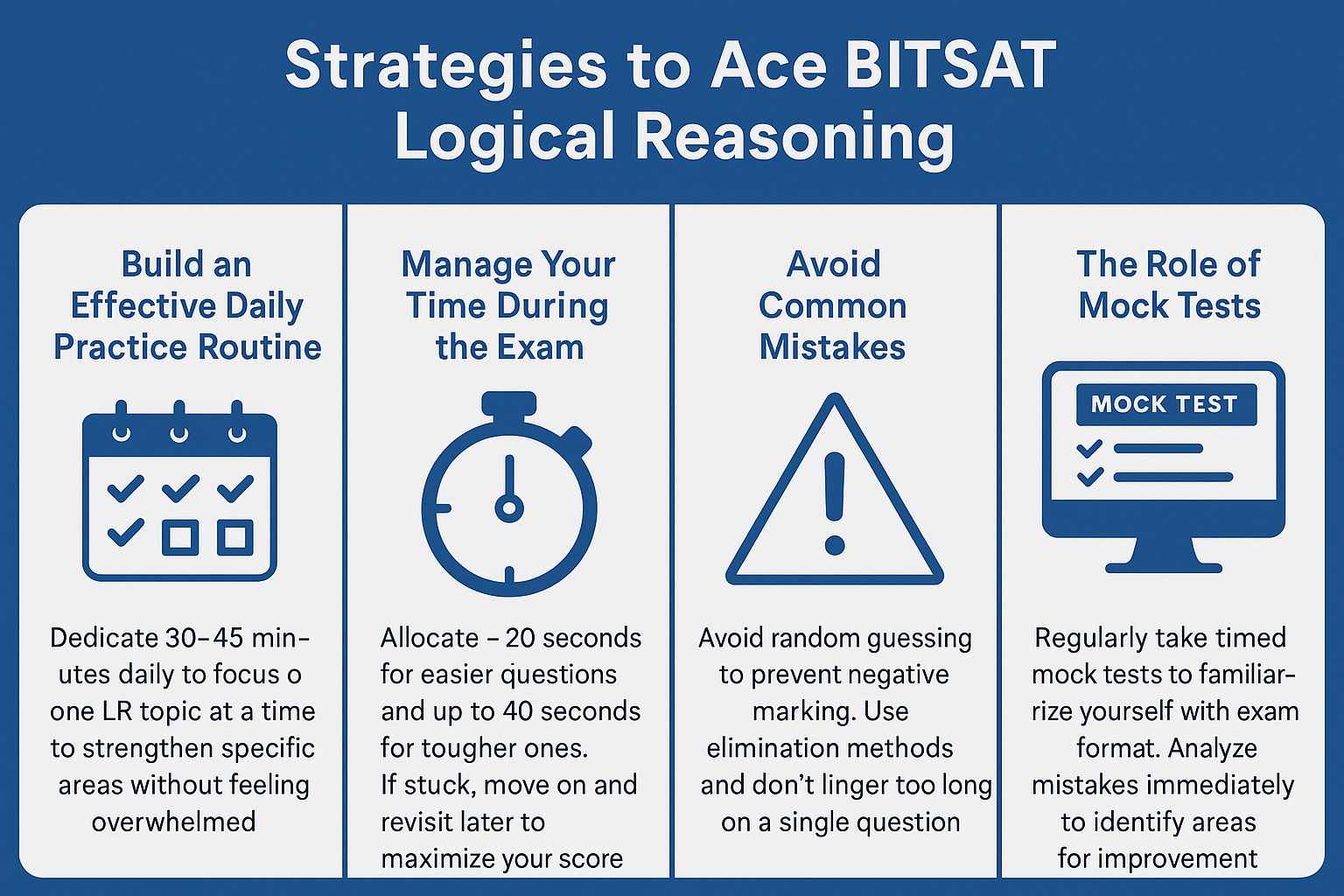Table of Contents
- Logical Reasoning in BITSAT
- Understanding the Logical Reasoning Syllabus BITSAT
- Key Topics and Concepts to Focus On
- Strategies to Ace BITSAT Logical Reasoning
- Study Materials and Resources
- Overcoming Last-Minute Stress
- Tips from BITSAT Toppers
- FAQs on Logical Reasoning in BITSAT
- Nail BITSAT Logical Reasoning and Beyond
How to Prepare for Logical Reasoning in BITSAT
Pratham Jiwnani
5/27/2025

How to Prepare for Logical Reasoning in BITSAT
Struggling with the Logical Reasoning (LR) section of BITSAT? You’re not alone—and trust me, I get it. It’s the part of the exam that often feels like an afterthought, yet it holds the power to seriously boost your score if you play it right.
The truth is, most students overlook LR, thinking it’s "easy," only to lose out on precious marks. But here’s the thing: this section can be your game-changer.
In this guide, we’ll dive into exactly how to master LR, from breaking down the syllabus to crafting a prep strategy that works. Ready to turn this into your secret weapon? Let’s go!
Logical Reasoning in BITSAT
Why Logical Reasoning Matters
Logical Reasoning may account for fewer marks in comparison to sections like Physics or Mathematics, but don’t underestimate its power. It’s an opportunity to score easy points quickly—with enough practice, you can breeze through these questions while saving time for harder sections.
The LR section in BITSAT consists of 20 questions, making it a key part of your strategy. It covers both verbal reasoning (think relationships and syllogisms) and non-verbal reasoning (patterns, puzzles, and geometry). Most questions demand critical thinking and a systematic approach rather than in-depth subject knowledge.
What Makes It Challenging?
The biggest challenge in Logical Reasoning is speed. You need to process information, analyze patterns, and deduce answers quickly. But don’t worry! Once you recognize the common question types and learn specific techniques, this section becomes a scoring goldmine.
Understanding the Logical Reasoning Syllabus BITSAT

The Logical Reasoning section in BITSAT evaluates your ability to think clearly and solve problems. It is divided into two parts: verbal and non-verbal reasoning. To do well, you’ll need to understand relationships, spot patterns, follow rules, and apply logical thinking to solve questions. Let’s break it down.
Verbal Reasoning Topics:
- Analogy: These questions test your ability to identify relationships. For example, if "A is to B as C is to D," you’ll figure out the missing element based on the pattern.
- Classification: Here, you group items based on shared qualities and identify which one doesn’t belong.
- Series Completion: You’ll work with sequences of numbers or letters and either finish the series or correct an error.
- Logical Deduction: These are passage-based questions where you’ll conclude. For instance, you might read a statement and decide if a conclusion logically follows.
- Chart Logic: You’ll complete partially filled tables or charts based on the given data.
Non-Verbal Reasoning Topics:
- Pattern Perception: You’ll analyze patterns, often with a missing part, and choose the correct piece to complete it.
- Figure Formation and Analysis: These involve assembling a complete figure from smaller pieces or analyzing how parts fit together.
- Paper Cutting: You’ll visualize how a folded and cut piece of paper will look when unfolded.
- Figure Matrix: You’ll look at figures in a grid, find the rule connecting them, and identify the missing piece.
- Rule Detection: You’ll apply a given rule to select the correct set of figures or complete a series.
Weightage and Preparation
While the exact distribution of questions can vary, verbal reasoning often carries slightly more weight. Focus on key areas like analogy, series completion, and pattern perception, as these are common. Practice solving these types of problems regularly to build speed and accuracy. Check out the official BITSAT syllabus 2025 page.
Key Topics and Concepts to Focus On

Series Completion and Pattern Recognition
These questions test your ability to identify patterns or sequences in numbers, letters, or figures.
- Example:
- Find the next number in the sequence: 2, 6, 14, 30,?
- Answer: 62 (Pattern is multiplying by 2 and adding 2 each step).
- Find the next number in the sequence: 2, 6, 14, 30,?
Coding-Decoding Techniques
Practice recognizing the rules or patterns behind coded messages. For instance:
- Example:
- “If FLOW is coded as GNPX, what is the code for PARK?”
- Look for alphabetical shifts or pattern symmetry.
- “If FLOW is coded as GNPX, what is the code for PARK?”
Blood Relations and Family Trees
Understanding relationships in these problems can be tricky, but drawing family trees or simple diagrams can help you visualize connections and solve them faster. Take your time to map out the relationships clearly before attempting to answer.
Direction Sense and Spatial Reasoning
These questions test your ability to navigate and visualize spaces. To get them right, try sketching the directions or paths mentioned in the problem. A clear diagram can help you avoid confusion and keep track of all the details.
Logical Deductions and Syllogisms
Venn diagrams and structured reasoning are your best tools here. Practice the techniques regularly so you can apply them confidently during the actual questions. This will help you quickly identify valid conclusions without second-guessing.
Seating Arrangements and Puzzles
Begin with simpler practice problems to understand the basic patterns before moving on to more challenging setups. These questions often require patience and attention to detail, but with practice, you'll get faster and more accurate.
Strategies to Ace BITSAT Logical Reasoning

How to Build an Effective Daily Practice Routine
To improve your Logical Reasoning (LR) skills for BITSAT, set aside 30–45 minutes every day for practice. Focus on one topic at a time. This approach will help you strengthen specific areas without feeling overwhelmed.
Managing Your Time During the Exam
Time is everything in BITSAT. For easier questions, aim to spend about 20 seconds each. For tougher problems or puzzles, don’t take more than 40 seconds. If you’re stuck, move on and return to it later. Prioritizing the solvable questions is key to maximizing your score.
How to Avoid Common Mistakes
Random guessing often leads to negative marking, so avoid it. Instead, use elimination to narrow down the options. Also, don’t get stuck on a single question for too long—your goal is to solve as many questions as possible within the given time.
The Role of Mock Tests
Mock tests are one of the best tools for BITSAT preparation. Take them regularly under timed conditions to get used to the exam format. Platforms like CrackIT offer great resources for realistic test simulations. After each test, analyze your mistakes immediately. Check out the comprehensive BITSAT mock test strategy blog, this will help you figure out where you need to improve.
For more tips on preparation for BITSAT, check out this resource: How to Prepare for BITSAT. It’s packed with strategies to help you get exam-ready.
Study Materials and Resources
Equip yourself with the right resources:
- Books:
- A Modern Approach to Logical Reasoning by R.S. Aggarwal
- Logical Reasoning for the CAT by Nishit Sinha (great for tough puzzles)
- Online Tools and Apps:
- Platforms like CrackIT, which offer BITSAT mock tests created by top BITS and IIT alumni.
- Other free logical reasoning apps for daily practice.
- Past Year Question Papers:
- Solve BITSAT papers from previous years to understand trends.
Overcoming Last-Minute Stress
Preparing for exams like BITSAT isn’t just about studying hard; it’s also about staying mentally prepared to perform your best on the big day.
- Stay Organized:
Make a quick reference sheet with important formulas, concepts, and shortcuts you tend to forget. Reviewing this before the exam can save you time and boost your confidence.
- Breathe and Relax:
Feeling overwhelmed is normal, but it’s important to stay calm. Try simple mindfulness exercises, like deep breathing or a short meditation, to help clear your head and reduce anxiety.
- Plan Your Approach:
Start with the easier questions to build momentum and gain confidence. Once you’ve tackled those, move on to the more challenging ones without spending too much time on any single question.
Tips from BITSAT Toppers
Preparing for BITSAT can feel overwhelming, but these tips from previous toppers can help you approach it with clarity:
- Balancing Sections
It’s easy to lose track of time on one section, especially Logical Reasoning (LR), but don’t let it take up too much of your focus. Make sure to distribute your time evenly across all sections to maximize your overall score.
- Consistency Over Cramming
Instead of long, last-minute study sessions, focus on regular, short practice sessions. Building a habit of consistent practice helps you retain concepts better and reduces exam day stress.
- Mock Test Strategy
Taking mock tests is a key part of preparation. Most toppers take at least 10 mock tests before the exam. This not only helps you manage time but also gives you a clear idea of how to approach the real test.
FAQs on Logical Reasoning in BITSAT
1. What is the weightage of Logical Reasoning in BITSAT?
The Logical Reasoning section in BITSAT has 20 questions, each worth 3 marks, making up 60 out of the total 390 marks. While it’s a smaller section compared to others, it’s still important. If you prepare well, it can boost your score significantly. The questions are usually not too tricky, so with some focused practice, you can ace this part and gain an edge.
2. What types of questions are asked in the Logical Reasoning section?
Get ready for a mental workout! The LR section includes questions on:
- Series completion and pattern recognition
- Coding-decoding
- Blood relations
- Direction sense
- Logical deduction and syllogisms
- Seating arrangements and puzzles
It's like solving mysteries with logic as your sidekick!
3. Which books are recommended for LR preparation?
For your LR prep arsenal, consider these excellent resources:
- BITSAT English Proficiency & Logical Reasoning by Disha Experts
- The Pearson Complete Guide to the BITSAT
- A Modern Approach to Logical Reasoning by R.S. Aggarwal
4. How much time should I dedicate to LR preparation daily?
Practicing for 30 minutes to an hour every day can make a big difference in your preparation. Staying consistent is key over time; you'll see noticeable improvements in both your speed and accuracy as you work through questions. It’s all about building those mental habits with regular effort.
5. Are mock tests beneficial for LR preparation?
Mock tests are an essential part of your BITSAT preparation. They help you understand how to manage your time effectively during the exam, get familiar with the question patterns, and identify areas where you need to improve. By practicing regularly, you can track your progress and build confidence as you see your scores improve. It’s a simple but powerful way to prepare better and feel more ready for the actual test.
6. Is the LR section in BITSAT more challenging than other exams?
Many students find the Logical Reasoning (LR) section in BITSAT challenging, especially with the time pressure of the exam. It's understandable: time management is key here. The best way to tackle this is with consistent practice and a clear understanding of the question patterns. Focus on building speed and accuracy, and you'll gradually get more comfortable with this section. Remember, it's all about staying calm, practicing regularly, and refining your approach.
7. Can I skip LR preparation to focus on other sections?
Skipping Logical Reasoning in BITSAT might seem tempting since it carries fewer marks, but that’s a mistake you don’t want to make. Every section matters, and every point adds to your total score. Logical Reasoning may be a smaller section, but it’s often less time-consuming and can give you an edge if you approach it with focus. A balanced strategy ensures you’re not leaving easy marks behind, so make sure to give this section the attention it deserves.
8. How can I improve my speed in solving LR questions?
Speed and accuracy go hand in hand when tackling exams like BITSAT. To improve both, focus on a few key strategies. Start with regular, timed practice sessions to get used to the pressure of solving questions quickly. Learn efficient shortcuts and solving techniques to save time without compromising accuracy. Finally, review your mock tests carefully. Pay attention to the mistakes you make and understand where you went wrong so you can avoid repeating them. Consistent practice with these steps will help you perform better.
Nail BITSAT Logical Reasoning and Beyond
Logical Reasoning can transform your BITSAT performance–if you prepare smartly. By mastering question types, leveraging the right resources, and practicing with purpose, you position yourself to excel in this section.
Good luck, future BITSian! Need expert guidance? Check out CrackIT's personalized mentorship programs for top-notch results.
Categories
Join the Discussion
0 comments